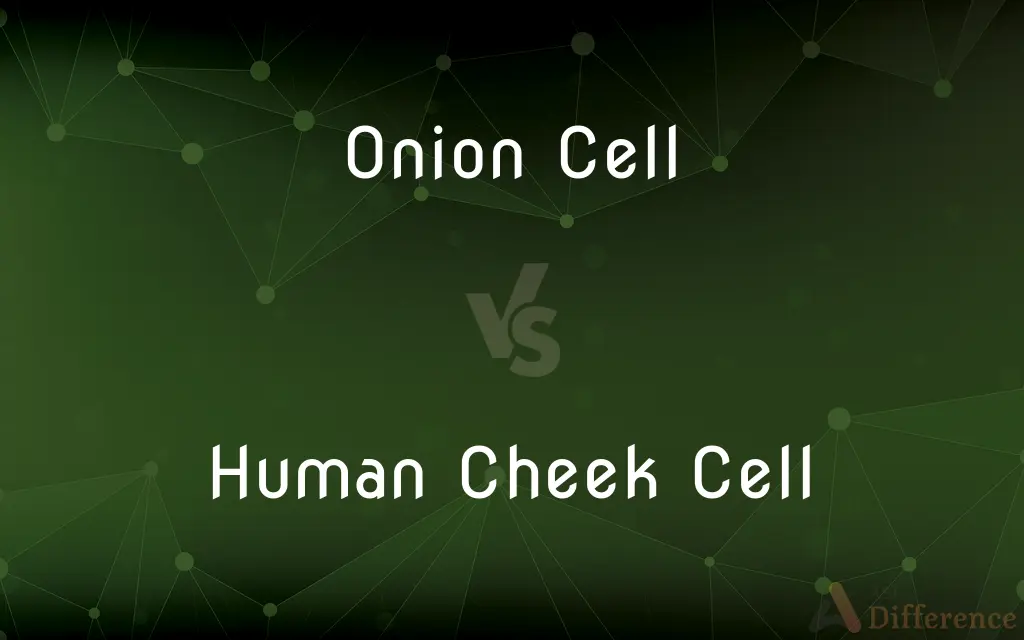Onion Cell vs. Human Cheek Cell — What's the Difference?
Edited by Tayyaba Rehman — By Fiza Rafique — Published on December 26, 2023
Onion Cell is a plant cell with a rigid cell wall; Human Cheek Cell is an animal cell lacking a cell wall but has a flexible cell membrane.

Difference Between Onion Cell and Human Cheek Cell
Table of Contents
ADVERTISEMENT
Key Differences
The Onion Cell and the Human Cheek Cell serve as quintessential examples of plant and animal cells, respectively. Onion Cells are characteristic of plant cells, possessing cell walls made of cellulose which provide structure and support. On the flip side, Human Cheek Cells, being animal cells, lack this cell wall, making them flexible and giving them a different appearance under the microscope.
From a structural perspective, the Onion Cell exhibits a large central vacuole, which stores nutrients and waste products. This vacuole, when filled, pushes the cell's contents toward the cell wall, making the cell appear more spacious. In contrast, the Human Cheek Cell doesn't have such a pronounced vacuole, and its organelles are more spread out within the cytoplasm.
Another distinguishing factor between the Onion Cell and the Human Cheek Cell lies in their chloroplasts, or lack thereof. The Onion Cell, being from a plant, contains chloroplasts — the sites of photosynthesis where sunlight is converted into energy. The Human Cheek Cell, being an animal cell, lacks chloroplasts as animals don't photosynthesize.
From a functional standpoint, both the Onion Cell and Human Cheek Cell play unique roles in their respective organisms. While Onion Cells engage in processes such as photosynthesis and contribute to the overall structure of the plant, Human Cheek Cells aid in forming the lining of the mouth, providing a barrier against pathogens and aiding in the sensation of taste.
Comparison Chart
Structural Component
Contains a rigid cell wall made of cellulose
Lacks a cell wall, has a flexible cell membrane
ADVERTISEMENT
Central Vacuole
Large and prominent, storing nutrients and wastes
Less pronounced or absent
Chloroplasts
Present, for photosynthesis
Absent, as they don't photosynthesize
Primary Function
Photosynthesis, structural support for plant
Forming the mouth's lining, barrier against pathogens
Presence of Lysosomes
Generally absent
Present, containing digestive enzymes
Compare with Definitions
Onion Cell
A plant cell with a distinct cell wall.
The Onion Cell's large vacuole is evident under a microscope.
Human Cheek Cell
A typical animal cell lacking a cell wall.
The Human Cheek Cell's flexible membrane can be observed under the microscope.
Onion Cell
Contains chloroplasts for photosynthesis.
Chloroplasts in the Onion Cell enable it to harness sunlight.
Human Cheek Cell
Contains lysosomes with digestive enzymes.
Lysosomes in the Human Cheek Cell aid in breaking down cellular waste.
Onion Cell
Lacks lysosomes commonly found in animal cells.
Unlike animal cells, the Onion Cell doesn't typically contain lysosomes.
Human Cheek Cell
Lacks chloroplasts present in plant cells.
Unlike plant cells, the Human Cheek Cell doesn't photosynthesize.
Onion Cell
Constituent of onion epidermis.
You can observe Onion Cells using a simple light microscope slide preparation.
Human Cheek Cell
Plays a role in oral sensation and protection.
The Human Cheek Cell is integral to the mouth's defense against external pathogens.
Onion Cell
Exhibits a rectangular shape due to its wall.
The Onion Cell's rigid structure is due to its cellulosic wall.
Human Cheek Cell
Found in the inner lining of the mouth.
A simple swab can collect Human Cheek Cells for observation.
Common Curiosities
What's the primary structural difference between Onion Cell and Human Cheek Cell?
The Onion Cell has a rigid cell wall, while the Human Cheek Cell lacks one.
Do Human Cheek Cells photosynthesize?
No, Human Cheek Cells don't have chloroplasts and don't photosynthesize.
Why does the Onion Cell appear spacious under the microscope?
The Onion Cell's large central vacuole pushes its contents outward, giving a spacious appearance.
Where can you find Human Cheek Cells?
Human Cheek Cells form the inner lining of the mouth.
What is the primary function of the Onion Cell's chloroplasts?
Chloroplasts in the Onion Cell are responsible for photosynthesis.
Do Human Cheek Cells have a large central vacuole like Onion Cells?
No, Human Cheek Cells don't have a pronounced central vacuole like Onion Cells.
What gives the Onion Cell its rigid structure?
The cellulose cell wall provides the Onion Cell with its rigidity.
What is the significance of the Onion Cell in biology education?
The Onion Cell is often used in education due to its clear visibility and as a classic plant cell example.
Is it easy to obtain Human Cheek Cells for observation?
Yes, a simple swab from the inner cheek can collect Human Cheek Cells.
How do Human Cheek Cells aid in defense?
Human Cheek Cells form a barrier in the mouth against pathogens and foreign particles.
Can you see the nucleus in both Onion Cells and Human Cheek Cells under a microscope?
Yes, with proper staining, the nucleus is visible in both cell types.
What gives Onion Cells their rectangular shape?
The rigid cell wall gives Onion Cells a rectangular shape.
Why don't Onion Cells have lysosomes?
Lysosomes are more typical of animal cells, and Onion Cells generally lack them.
Share Your Discovery

Previous Comparison
Carbohydrates vs. Proteins
Next Comparison
5’11 vs. 6Author Spotlight
Written by
Fiza RafiqueFiza Rafique is a skilled content writer at AskDifference.com, where she meticulously refines and enhances written pieces. Drawing from her vast editorial expertise, Fiza ensures clarity, accuracy, and precision in every article. Passionate about language, she continually seeks to elevate the quality of content for readers worldwide.
Edited by
Tayyaba RehmanTayyaba Rehman is a distinguished writer, currently serving as a primary contributor to askdifference.com. As a researcher in semantics and etymology, Tayyaba's passion for the complexity of languages and their distinctions has found a perfect home on the platform. Tayyaba delves into the intricacies of language, distinguishing between commonly confused words and phrases, thereby providing clarity for readers worldwide.
















































